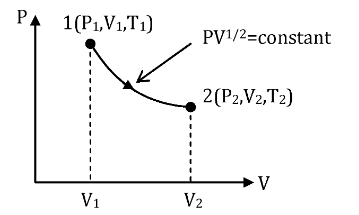
Thermodynamic process is shown below on a P-V diagram for one mole of an ideal gas. If V2 = 2V1 then the ratio of temperature T2/T1 is:

Answer
221.4k+ views
Hint: The above diagram represents how the pressure, volume and temperature of the ideal gas vary when going from state 1 to state 2. The relation between pressure and volume is given in the diagram. Since the system consists of an ideal gas, the ideal gas equation holds good. Equating the two relations should give you the answer.
Complete Step by Step Solution:
The P-V diagram shown above represents the change in pressure (P), volume (V) and temperature (T) when the given system of one mole of an ideal gas moves from state 1 to state 2. It is also given that during the process, pressure and volume obey the relation \[P{V^{1/2}} = \]constant (\[k\]) … (1)
We are required to calculate \[\dfrac{{{T_2}}}{{{T_1}}}\] if volumes V1 and V2 were related as \[{V_2} = 2{V_1}\] … (2)
Since the system consists of one mole of an ideal gas, the ideal gas equation \[PV = nRT\]holds good in this case where \[n = 1\]. Thus, the ideal gas equation becomes \[PV = RT\] … (3)
where R is the gas constant.
Equation (3) can be rewritten as \[PV = RT \Rightarrow T = \dfrac{{PV}}{R}\]
\[ \Rightarrow T = \dfrac{{P\sqrt V \times \sqrt V }}{R}\]
\[ \Rightarrow T = \dfrac{{k\sqrt V }}{R}\] [from equation (1)] … (4)
For states 1 and 2, equation (4) becomes \[{T_1} = \dfrac{{k\sqrt {{V_1}} }}{R}\] and \[{T_2} = \dfrac{{k\sqrt {{V_2}} }}{R}\]respectively.
Thus, \[\dfrac{{{T_1}}}{{{T_2}}} = \dfrac{{\left( {\dfrac{{k\sqrt {{V_1}} }}{R}} \right)}}{{\left( {\dfrac{{k\sqrt {{V_2}} }}{R}} \right)}}\]
\[ \Rightarrow \dfrac{{{T_1}}}{{{T_2}}} = \dfrac{{\sqrt {{V_1}} }}{{\sqrt {{V_2}} }}\]
\[ \Rightarrow \dfrac{{{T_1}}}{{{T_2}}} = \dfrac{{\sqrt {{V_1}} }}{{\sqrt {2{V_1}} }}\] [from equation (2)]
\[ \Rightarrow \dfrac{{{T_1}}}{{{T_2}}} = \dfrac{1}{{\sqrt 2 }}\]
\[ \Rightarrow \dfrac{{{T_2}}}{{{T_1}}} = \dfrac{{\sqrt 2 }}{1}\]
Thus, the ratio \[\dfrac{{{T_2}}}{{{T_1}}} = \dfrac{{\sqrt 2 }}{1}\] if V2=2V1.
Note: In this process, since there is an increase in volume and a decrease in pressure, the process is an expansion process. Here, pressure and volume obey the general relation \[P{V^\gamma } = \] constant thus, the process can be considered to be an adiabatic expansion.
Complete Step by Step Solution:
The P-V diagram shown above represents the change in pressure (P), volume (V) and temperature (T) when the given system of one mole of an ideal gas moves from state 1 to state 2. It is also given that during the process, pressure and volume obey the relation \[P{V^{1/2}} = \]constant (\[k\]) … (1)
We are required to calculate \[\dfrac{{{T_2}}}{{{T_1}}}\] if volumes V1 and V2 were related as \[{V_2} = 2{V_1}\] … (2)
Since the system consists of one mole of an ideal gas, the ideal gas equation \[PV = nRT\]holds good in this case where \[n = 1\]. Thus, the ideal gas equation becomes \[PV = RT\] … (3)
where R is the gas constant.
Equation (3) can be rewritten as \[PV = RT \Rightarrow T = \dfrac{{PV}}{R}\]
\[ \Rightarrow T = \dfrac{{P\sqrt V \times \sqrt V }}{R}\]
\[ \Rightarrow T = \dfrac{{k\sqrt V }}{R}\] [from equation (1)] … (4)
For states 1 and 2, equation (4) becomes \[{T_1} = \dfrac{{k\sqrt {{V_1}} }}{R}\] and \[{T_2} = \dfrac{{k\sqrt {{V_2}} }}{R}\]respectively.
Thus, \[\dfrac{{{T_1}}}{{{T_2}}} = \dfrac{{\left( {\dfrac{{k\sqrt {{V_1}} }}{R}} \right)}}{{\left( {\dfrac{{k\sqrt {{V_2}} }}{R}} \right)}}\]
\[ \Rightarrow \dfrac{{{T_1}}}{{{T_2}}} = \dfrac{{\sqrt {{V_1}} }}{{\sqrt {{V_2}} }}\]
\[ \Rightarrow \dfrac{{{T_1}}}{{{T_2}}} = \dfrac{{\sqrt {{V_1}} }}{{\sqrt {2{V_1}} }}\] [from equation (2)]
\[ \Rightarrow \dfrac{{{T_1}}}{{{T_2}}} = \dfrac{1}{{\sqrt 2 }}\]
\[ \Rightarrow \dfrac{{{T_2}}}{{{T_1}}} = \dfrac{{\sqrt 2 }}{1}\]
Thus, the ratio \[\dfrac{{{T_2}}}{{{T_1}}} = \dfrac{{\sqrt 2 }}{1}\] if V2=2V1.
Note: In this process, since there is an increase in volume and a decrease in pressure, the process is an expansion process. Here, pressure and volume obey the general relation \[P{V^\gamma } = \] constant thus, the process can be considered to be an adiabatic expansion.
Recently Updated Pages
JEE Main 2022 (July 26th Shift 1) Physics Question Paper with Answer Key

JEE Main 2022 (June 26th Shift 2) Chemistry Question Paper with Answer Key

Apparent Frequency Explained: Formula, Uses & Examples

JEE Main 2023 (January 30th Shift 2) Chemistry Question Paper with Answer Key

Displacement Current and Maxwell’s Equations Explained

JEE Main 2022 (June 29th Shift 1) Maths Question Paper with Answer Key

Trending doubts
JEE Main 2026: Application Form Open, Exam Dates, Syllabus, Eligibility & Question Papers

Derivation of Equation of Trajectory Explained for Students

Hybridisation in Chemistry – Concept, Types & Applications

Understanding the Angle of Deviation in a Prism

How to Convert a Galvanometer into an Ammeter or Voltmeter

Degree of Dissociation: Meaning, Formula, Calculation & Uses

Other Pages
NCERT Solutions For Class 11 Chemistry Chapter 7 Redox Reaction

JEE Advanced Marks vs Ranks 2025: Understanding Category-wise Qualifying Marks and Previous Year Cut-offs

Hydrocarbons Class 11 Chemistry Chapter 9 CBSE Notes - 2025-26

Thermodynamics Class 11 Chemistry Chapter 5 CBSE Notes - 2025-26

NCERT Solutions ForClass 11 Chemistry Chapter Chapter 5 Thermodynamics

Equilibrium Class 11 Chemistry Chapter 6 CBSE Notes - 2025-26




